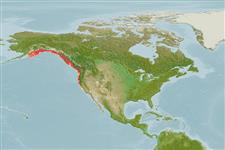>
Perciformes/Scorpaenoidei (Scorpionfishes) >
Sebastidae (Rockfishes, rockcods and thornyheads) > Sebastinae
Etymology: Sebastes: Greek, sebastes = august, venerable (Ref. 45335); maliger: From the Greek malus meaning mast and gero meaning 'magnificent' and 'to bear' (Ref. 27436).
More on authors: Jordan & Gilbert.
Environment: milieu / climate zone / depth range / distribution range
Ökologie
seewasser demersal; tiefenbereich 0 - 274 m (Ref. 27437), usually 0 - 92 m (Ref. 27437). Temperate; 8°C - 16°C (Ref. 131064); 61°N - 33°N, 163°W - 118°W
Eastern Pacific: From Shumagin Islands, Prince William Sound and Gulf of Alaska to San Miguel Island, southern California, USA.
Length at first maturity / Size / Gewicht / Alter
Maturity: Lm 31.0 range ? - ? cm
Max length : 61.0 cm TL Männchen/unbestimmt; (Ref. 2850); max. veröff. Gewicht: 3.3 kg (Ref. 40637); max. veröff. Alter: 90 Jahre (Ref. 55421)
Rückenflossenstacheln (insgesamt) : 13; Rückenflossenweichstrahlen (insgesamt) : 12 - 14; Afterflossenstacheln: 3; Afterflossenweichstrahlen: 6 - 7. Head spines strong - nasal, preocular, postocular, tympanic and parietal spines present, supraocular, coronal and nuchal spines absent (Ref. 27437). Spinous dorsal with deeply incised membranes (Ref. 27437). Caudal fin rounded (Ref. 6885). Body mottled brown, distinct yellow areas above (including part of spinous dorsal), orange-brown spotting on lower anterior area (Ref. 27437).
Inhabit rocky bottoms and reefs, usually solitary on the bottom or hovering just above the bottom, but never far from cover (Ref. 27436, 27437). Viviparous (Ref. 34817). Marketed as fillets (Ref. 27436).
Eschmeyer, W.N., E.S. Herald and H. Hammann, 1983. A field guide to Pacific coast fishes of North America. Boston (MA, USA): Houghton Mifflin Company. xii+336 p. (Ref. 2850)
IUCN Rote Liste Status (Ref. 130435: Version 2024-1)
Bedrohung für Menschen
Harmless
Nutzung durch Menschen
Fischereien: kommerziell; Sportfisch: ja; Aquarium: Öffentliche Aquarien
Tools
Zusatzinformationen
Download XML
Internet Quellen
Estimates based on models
Preferred temperature (Ref.
123201): 6.3 - 11.1, mean 9 °C (based on 312 cells).
Phylogenetic diversity index (Ref.
82804): PD
50 = 0.5000 [Uniqueness, from 0.5 = low to 2.0 = high].
Bayesian length-weight: a=0.01000 (0.00495 - 0.02022), b=3.09 (2.92 - 3.26), in cm total length, based on LWR estimates for this Genus-body shape (Ref.
93245).
Trophic level (Ref.
69278): 3.8 ±0.4 se; based on diet studies.
Widerstandsfähigkeit (Ref.
120179): niedrig, Verdopplung der Population dauert 4,5 - 14 Jahre. (tm=7; tmax=95).
Fishing Vulnerability (Ref.
59153): Moderate vulnerability (44 of 100).
Nutrients (Ref.
124155): Calcium = 20.9 [7.8, 60.3] mg/100g; Iron = 0.206 [0.086, 0.475] mg/100g; Protein = 18.2 [17.0, 19.3] %; Omega3 = 1.17 [0.50, 2.88] g/100g; Selenium = 39 [16, 111] μg/100g; VitaminA = 15.1 [4.9, 46.1] μg/100g; Zinc = 0.392 [0.207, 0.695] mg/100g (wet weight);
